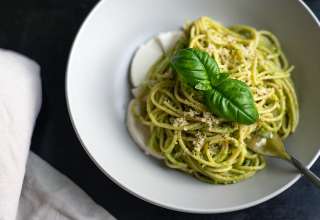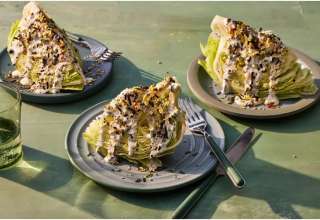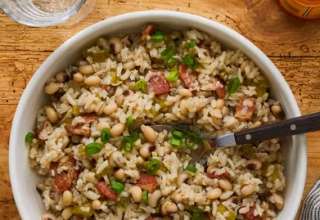
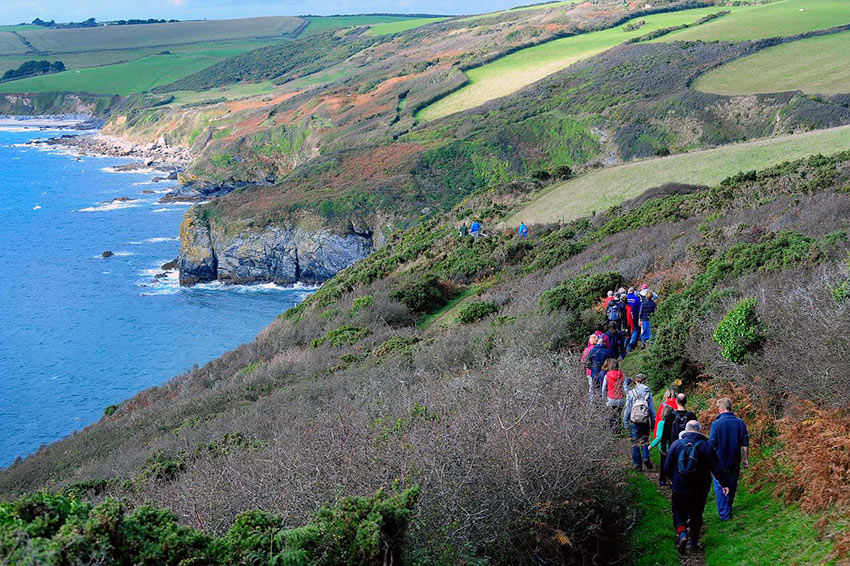
Until recently Britain was portrayed as a culinary wasteland, home to overcooked, boring food and an abundance of uninspired bland chefs. There were only a few tasty exceptions to their miserable repertoire — namely, fish ‘n’ chips, tea, beer and dessert. In this decade, respected food critics have reversed the hype, citing a virtual renaissance in the London food scene — raving about the hot new London chefs, touting its incredibly diverse restaurants, in fact anointing London as the Crown Jewel of European cuisine… London, London, LONDON! !!
The real question is… what happens when you leave the city? Are you back in a world of sub par dining? Is the rest of the country still an abyss of mushy vegetables and lumps of gray indistinguishable meat?
Well the answer is a resounding NO! Today the English countryside offers some of the most consistently appetizing, delightfully satisfying FRESH fare a traveler could hope for. The vast majority of local pubs, inns and bed & breakfasts scattered across Britain boast menus of substantial variety and above-average quality.
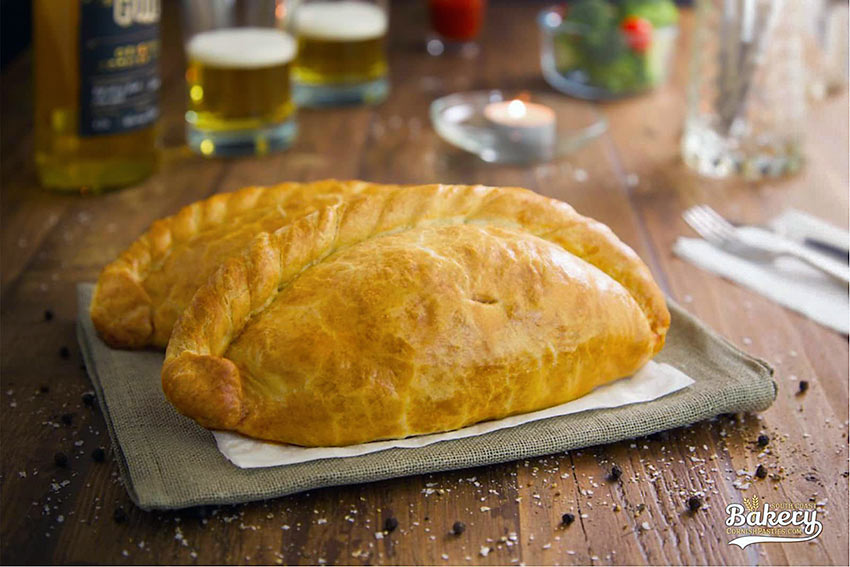
But increasingly, fresh ingredients are a rarity in restaurant food, especially for us nomads on the road. Perhaps because Britain is an island, still largely agricultural outside of London proper, many products are locally grown. Whether or not that’s the reason, the fact is that the base ingredients used by English locals have a farmer’s market level of quality and no long-standing relationship with plastic containers, chemicals or freezers to interfere with natural taste. Fruits and greens are crisp and just picked from the garden, home baked breads and pastries are noticeably textured, fish tastes barely plucked from the sea, cheeses creamy, nutty or tangy, but bursting with flavor-the offerings vary, but the sum total of these parts is nothing short of sublime.
Although I’ve had occasion to visit the U.K. many times over the years, this past summer I traipsed across the island with a twenty-something city crowd visiting for the very first time. Our route initially curved south through the small villages of Sussex and Kent, amidst cascading bouquets of flowering vines, hollyhocks, 7-foot wide roads and ancient castles. Then on west to Cornwall with its uniquely quaint fishing villages dotting the shoreline and its famously breathtaking coastal scenery.
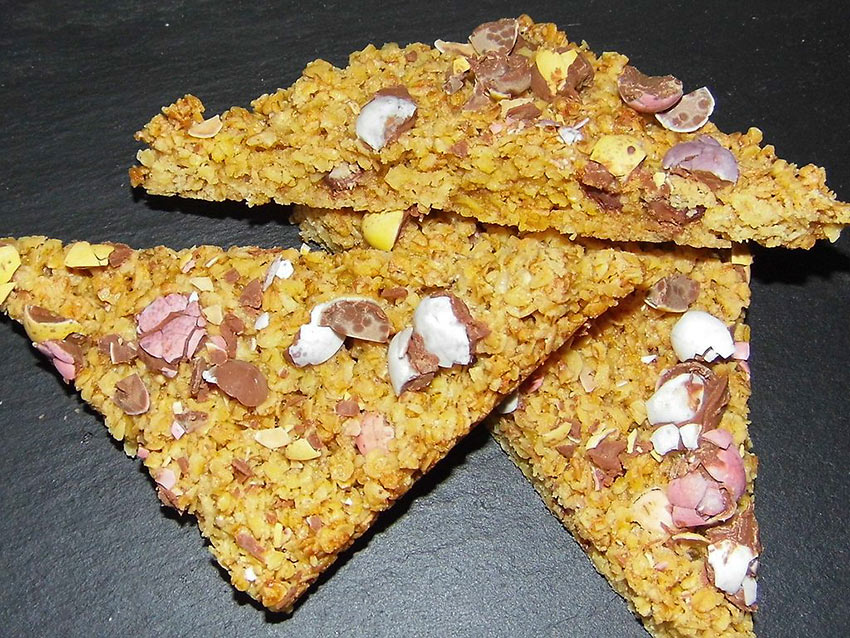
I finally got a taste of real Cornish flapjacks — yes, they’re different — soft, dense and chewy, these porridge oat bars were totally addictive and surprisingly decadent for just three ingredients: 6 oz. Demerarer sugar, 6 oz. soft tub margarine (or butter), melted together with just 8 oz. of oatmeal, topped with mini egg pieces, (!) then baked for 30 minutes.
Along the way we happily ate and drank to excess, routinely asking to partake of the warm and friendly specialties of the house. We sampled all the peasant staples: crispy fish ‘n chips, steak & mushroom and cheese & onion pies, dip-in egg cups, cock-a-leekie soup, Cornish pasties, bangers and mash, toad in the hole, shepherd’s pie, the ubiquitous ploughman’s lunch, fish cakes, bubble and squeak, Welsh rarebit, cheese straws, John Dory, and roast lamb with mint chutney, to name a few, followed by a never ending selection of desserts, such as shortbread, fruit trifle, spicy gingerbread, sticky toffee and bread & butter pudding, cream cakes, pies and custards galore. Of course most establishments offered many less traditional options as well, reflecting ethnic trends that are not restricted to the city.
And oh, the English beer… we mustn’t forget the libations! An incredible array of our favorite ale styles — mild, bitter, best bitter, porter, stout, barley wine — not to mention hard ciders, lagers and lime and shandies. All luscious and at the proper temperature, of course. We seriously almost lost some of our party permanently to the small village of in St Just, after sampling the finest, creamiest hand pumped Real Ale imaginable in the (only) local pub. I could retire here based on the beer alone, plus there were young folks inside as well.

But that was when, and this is now: Jonny McFadden, who runs the Star Inn in St Just, Cornwall, installed an electric fence in front of the pub’s bar for social distancing purposes. “We have had enough of people doing as they pleased and ignoring social-distancing guidelines,” said McFadden. “The fence had been placed there to, ahem, shock locals into behaving. To protect staff and myself and my customers you have to put in the meter [distancing] rule,” he said. Asked how customers reacted to the innovation, McFadden said, “It was quite comical. We’re in a rural area, so everybody knows what an electric fence is. I got a little sign too on it — ‘electric, danger.'”
Inevitably, in the course of our sampling, we made friends of all ages. A gentle couple in Lewes who found my oh-so-youthful companions most entertaining invited us into their home to share a traditional tea. They had a lovely manor estate complete with a croquet lawn, a wishing well and a glorious tended garden too pretty for words. The fellow next door owned homing pigeons and about 60 of them dotted his roof.
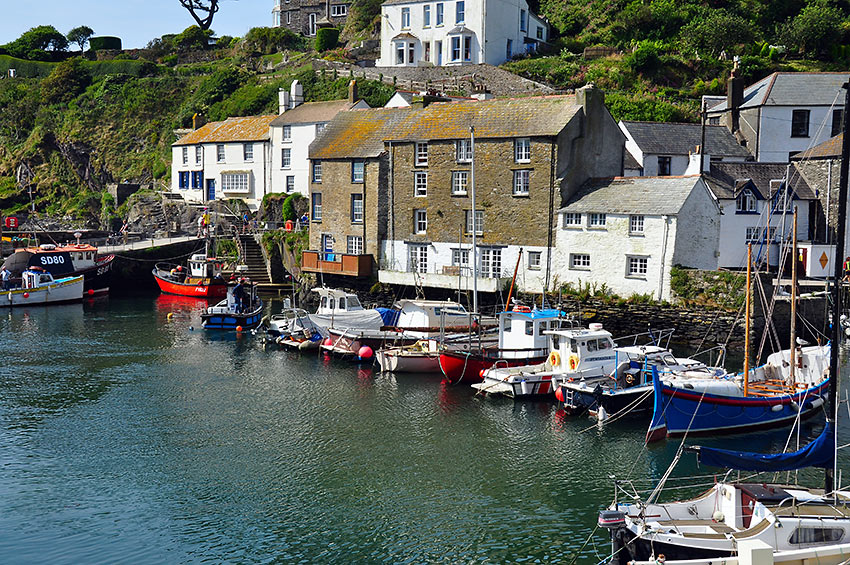
Once in Looe, we enjoyed an incredibly picturesque 180 degree view of the harbor from our bedroom window at the Deganwy Hotel perched on the hill overlooking the harbor, only a hundred yards or so walk from the station. Our luck held out even at the beach, which was sandy, sunlit and full of mostly British tourists. After sunning, we consumed a host of Cornish pasties, mostly sold as take-out. Each shop seemed to have their own slant on construction and fillings, offering us no choice but to sample them all. We ate potato and lamb and mushroom and onion and cheddar and beef and olive and chicken. A few were hefty with dough similar to a calzone; the majority were rich and flaky with a lot of shortening in the crust.

Looe itself proved to be a quaint, quiet fishing village with lovely pubs and lots of souvenir shops, bustling but not overrun with curious visitors. By far it’s best attribute, though, was its starting point for the 5-mile mostly cliff-side Looe to Polperro Walk, finishing at the next pretty fishing village up the coast. Full of incredible vistas, hauntingly beautiful rolling hills, a vivid assortment of flora and fauna and the constant sights, smells and sounds of the sea below you, it is an unforgettable sensory experience. While much of the hike was leisurely, some of the final uphill stretches were fairly aerobic, a good thing considering the delectable Cornish Clotted Ice Creams available in the teeny Talland bay shortly before its Polperro end. Without a doubt, this coastal walk was the stunning highlight of our trip.
Our hike ended on a winding street which brought us quietly down into the picturesque fishing village of Polperro. As in Looe, clusters of cottages perch on steep slopes overlooking the boats in the harbor. Narrow cobblestone streets abound in between tightly spaced homes, gurgling waterways and footbridges, garden window boxes and brightly colored flowers. The high street is tiny, so a bit crowded, but charming. Working our way slowly up the main street incline to the bus stop, we were stopped by some friendly ladies at a church yard sale. Comically, there we purchased all sorts of unique treasures, new and old, to bring back to the States… and a few homemade flapjacks for the ride home.
Getting There
If you haven’t yet toured the British countryside, here are my tips for sights and flavors you will want to sample along the way, and several ways to accomplish your travel.
TIP: Lunch is usually served from noon to 3 p.m.; the time of day to enjoy your large meal of the day throughout Britain. Prices are generally less, portions are generous — you will save a considerable amount of your travel budget by eating more at mid-day and enjoying a light meal, say soup and sandwich or salad for supper.
TIP: You can generally tell if you are drinking Real Ale if it is served using a hand pump.

TIP: Some B&Bs will help arrange for car and/or car and driver hire for day trips about the area. B&B owners are also a wealth of information on local sights, tours and best meal options. Through photos and email, you can oft-times narrow down your choices and book the best establishment for your needs well in advance. This gives you time to establish a relationship and along with it, maximum planning ability and control over your travel budget.
TIP: One aspect of traveling the British countryside that truly cannot be missed is the walking tour. Whether initially you get where you’re going by train, car or bus, the most wonderful way to truly capture the essence of England is on foot. There are a mind-boggling 630 miles of superb walks promising “the ever present sense of the sea” just on the southwest coast alone… and that comprises only one of fifteen National Trails in England and Wales.
Audrey’s Recipe for Cornish Pasties
(makes 3 large)
Processor Dough
- 2 cups flour
- ½ teaspoon salt
- 1-tablespoon sugar
- 1 stick cold butter (or margarine or combination)
cut up - 1 egg, separated (yolk used in dough, white as glaze)
- 5 tablespoons ice water
- 1 Tablespoon milk (for wash)
Filling
- 2-3 medium potatoes, chopped in ½ inch cubes
(about 2 ½ cups) - 2-3 medium carrots, chopped in 3/8 inch pieces
(about 1 ¾ cups) - 1 med. large onion, diced ¼ inch (about 1 cup)
- 2 celery stalks, leaves okay, diced ¼ inch
(about ½ cup) - 1 pound ground beef or turkey (about 2 cups)
- 1-oz. packet beef au jus (or turkey) gravy mix or seasonings to taste
(*plus additional packet for gravy)
Gravy
- Reserved vegetable water
- 1 Tablespoon flour or cornstarch (optional)
- 1 packet au jus (or turkey) gravy mix
For the dough: Put the first four ingredients in an attached food processor bowl and process with a steel blade until the consistency of coarse meal (no big lumps). Add the egg yolk, and while the processor is running, add your ice water one tablespoon at a time, stopping as soon as the dough begins to clump. Process only until it forms a loose ball. Divide the dough into three pieces. Gently form each piece into a ball, cover with plastic wrap and set aside at room temperature. If the kitchen is too hot, put the dough in the refrigerator while you make the filling.
For the filling: Wash and scrub vegetables; there’s no need to peel. Place the cut up vegetables in a roomy pot. Add only enough water to cover and boil gently about four minutes until partially cooked. Reserve (drain and save) the boiled vegetable water for the gravy, increasing both the flavor and vitamin content of your meal. Next, saute the ground beef or turkey until cooked through. Don’t indiscriminately discard juices, but do skim any excessive grease if using a high fat ground. Add to the meat one package of gravy mix (I prefer au jus even with ground turkey) or season to taste with up to one teaspoon bouillon and a sprinkling of onion and garlic powder. Add the vegetables and briefly mix together; set aside.
Constructing the pasties: Lightly flour a flexible plastic mat or cutting board and roll out one dough ball into a round-ended oval measuring approximately 10 x 7 inches and about 1/8 inch thick. Carefully transfer the dough to an outside corner edge of a large baking tray, letting one long half of your oval dough hang over the side (see photo). You will not be able to move the pasty once filling is added. Mound a generous, tall amount of filling on the supported half of the dough, leaving a ¾ inch margin around the edge. Then fold over the other half on top to resemble a filled-in letter “D”. Press the edges together, then fold the outer edge in on top of itself again and press to seal shut. Repeat with remaining dough balls. If any holes or tears result, just press the dough together to repair. Make a 1-inch slit in the top of each pasty for steam to escape. Moisten the top of each pasty with a little milk before placing in the oven, and brush with beaten egg white about 10 minutes before done. This will keep your pasty crust soft and add a lovely glazed patina. Bake at 375 degrees a total of 25 – 30 minutes.
Gravy: Use the reserved vegetable water as the liquid called for in your gravy mix. Au jus style can be thickened slightly by adding a little flour or cornstarch to the dry mix and making a smooth paste before gradually adding the vegetable water. Stir or whisk frequently while cooking to prevent sticking.
TIPS:
- Any favorite pie crust recipe can be substituted for the pasty dough. Even (horrors!) store-bought pre-made pie crust works fine. Either way, the milk and egg wash steps will enhance your results.
- Kids love a happy face or other fun design on top of their pasty. For finicky children, cook the potatoes, carrots, onion and celery six minutes and smash together to achieve a more uniform texture (i.e., hide the veggies).
- If you want to make little pasties instead of larger ones, you will need almost twice the amount of dough (up to 2 recipes, see below) for the same amount of filling. Baking time may need to be reduced to as little as 20 minutes.
- Anytime you are doubling or otherwise increasing the dough recipe for the pasty crust, make sure to process only one 2-cup recipe at a time for optimum results. Larger quantities will not process as quickly or uniformly and your crust may end up tough and overworked.
- Pasties freeze well and reheat without major repercussions in the microwave.
There are no rules as to quantities or proportions with pasties. You can put in them what you like and have on hand, change the ratio of meat to veggies, etc.; do what you will. Any leftover meat or poultry, as long as it is not too dry, makes a fabulous pasty.
